
Concept: Researchers from the University of Liverpool have used a combination of machine learning and fundamental biology to predict the next emergence of the COVID-19 outbreak. The new algorithm has detected several potential strains of the virus.
Nature of Disruption: The model initially predicted mammals susceptible to known COVID-19 strains using biological patterns, which revealed 876 potential mammal species from 411 strains of the novel coronavirus. The objective is to find the species that could shelter several virus strains at once. In order to locate mammals getting infected, researchers trained the machine learning algorithm to search for patterns that increase the chance for many coronaviruses to infect them. According to the observation, species closely related to one’s suffering from the infection or sharing the same geographical space are at high risk of contracting the COVID-19 virus. Based on observations outlined by the algorithm, the Asian palm civet and greater horseshoe bat are supposed to be a host of 32 and 68 different coronaviruses, respectively, while species, including the European rabbit and the dromedary camel, the common hedgehog, might have a combination of SARS-CoV-2 with other, existing coronaviruses.

Discover B2B Marketing That Performs
Combine business intelligence and editorial excellence to reach engaged professionals across 36 leading media platforms.
Outlook: Patients suffering from the COVID-19 have flooded the hospitals and healthcare institutions. As the industry struggles to discover the cure, the outbreak of a new strain of COVID-19 was detected. Therefore, it is crucial for healthcare providers to spot where the next emergence would happen. However, it is a challenging task to predict the potential hosts of previously detected new virus strains. Researchers from the University of Liverpool have developed an AI algorithm that could help target new disease detection, potentially aiding to avoid the next pandemic before it begins.
This article was originally published in Verdict.co.uk





